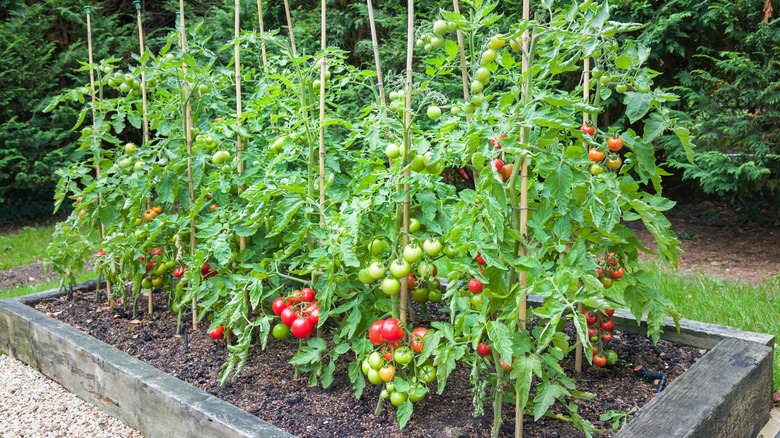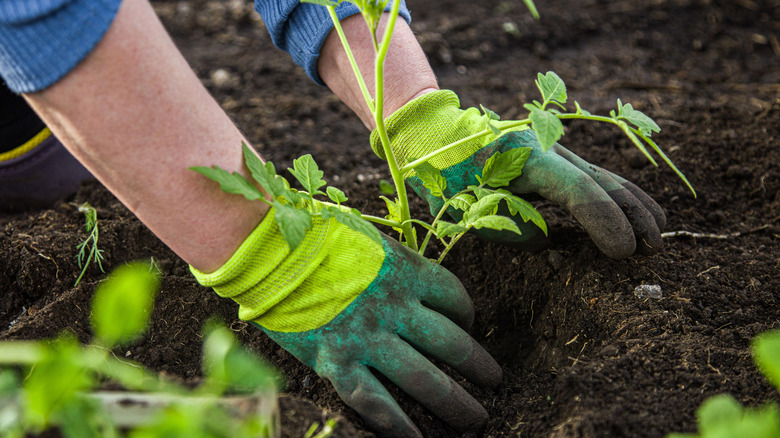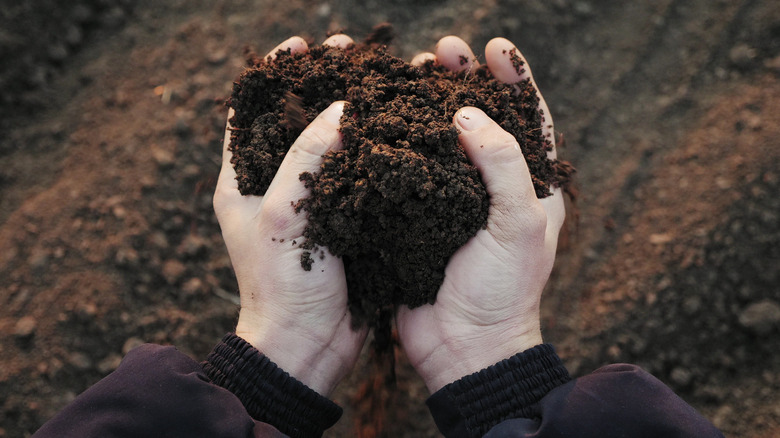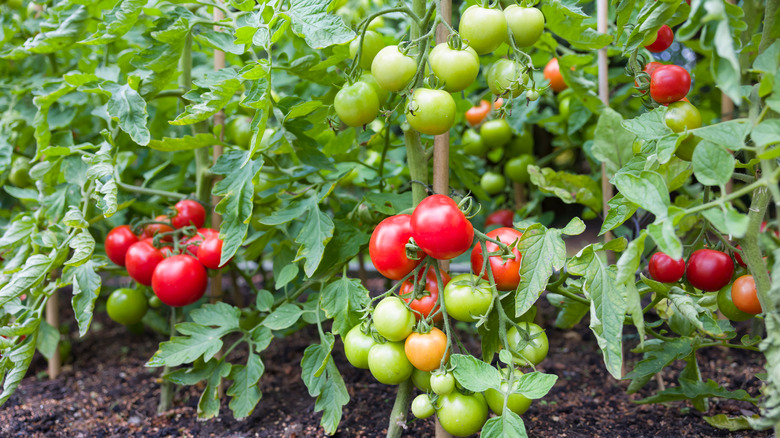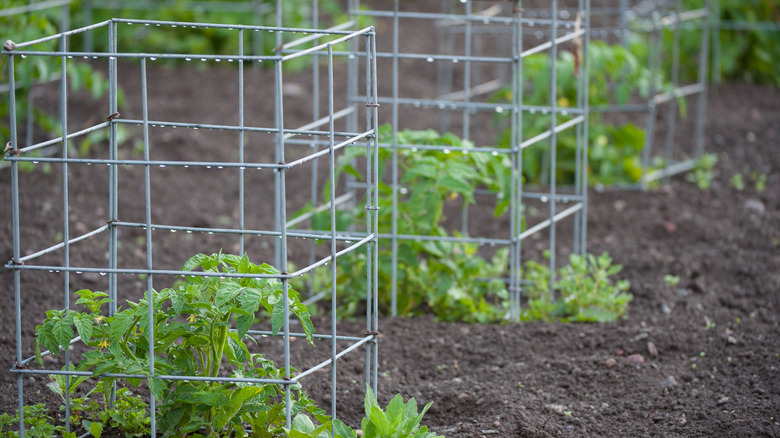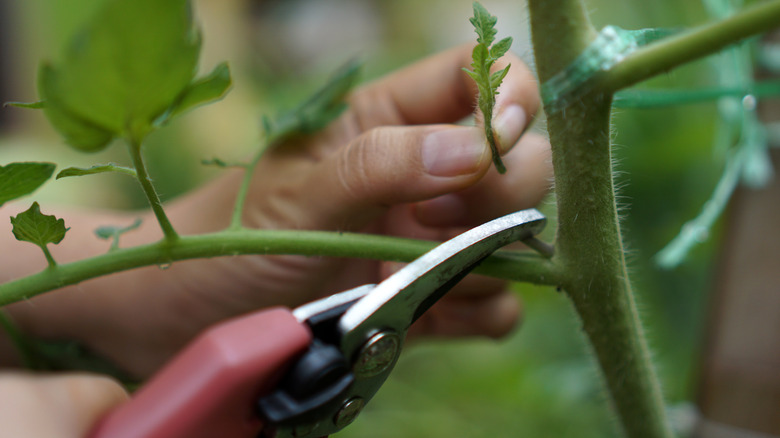Mistakes Everyone Makes When Planting Tomatoes
While many people pursue gardening for stress relief or to beautify their curb appeal, vegetable gardening provides a whole different level of satisfaction. You actually get to enjoy and eat the fruits of your labor! If you like the idea of growing your own food but aren't sure where to begin, tomatoes are one of the easier, more forgiving plants to try as you learn the ropes.
Even though they're easier, that doesn't mean you can stick seeds in the ground, walk away, and expect them to produce plump, flavorful tomatoes by summer's end. There are a handful of mistakes that everyone makes when planting tomatoes, but if you plan accordingly, you can avoid these pitfalls. You'll be well on your way to enjoying a plentiful, rewarding harvest. Start looking up recipes now and get your jars ready for homemade salsa. If you follow these tips, you'll have tomatoes coming out the wazoo.
Planting your tomatoes too early
Whether you're starting your tomatoes from seeds or buying plants from a garden center, it's important to be careful with timing. While some plants are fine to go in the ground as soon as the last frost has passed, tomatoes require a little bit more patience. If you plant them when the ground is still too cold, your crop is much more likely to struggle with disease or fail altogether.
According to University of California Master Gardener Rebecca Jepsen, "Planting too early in cooler temperatures can cause stunted growth, wilting, surface pitting, foliage necrosis and increased susceptibility to disease. Low soil temperatures can stunt plant growth and prevent root development." She suggests waiting until the ground temperature is between 55 and 65 degrees consistently.
Additionally, if your plants came from a warm, toasty greenhouse and you're going to stick them outside in 55 degrees, there's a process called "hardening off" that will help acclimate the plants to their new environment and prevent transplant shock. Jepsen suggests storing them in a garage, shed, or covered porch so they'll be protected from the elements. Then, place them outside in the shade for a couple hours each day, gradually increasing the increments until they're used to the new temperatures. This process will safeguard your tomatoes against breakage and sun damage.
Not amending the soil before planting tomatoes
In a perfect world, the dirt in our gardens would be rich with nutrients, easy to till, and possess balanced PH levels. We could start planting without a second thought. Unfortunately, though, you won't find this perfect dirt anywhere; gardeners amend their soil to make up for whatever it's lacking. Some find it easier to buy bags of garden soil instead of trying to fix the existing dirt.
Tomatoes require nutrient-rich soil in order to produce healthy, flavorful fruit. Tomato Dirt explains that nitrogen, potassium, and phosphorus are all necessary for optimal tomato production. Nitrogen helps the leaves of the plant, so if they're yellow or sickly-looking, that's a clear sign of nitrogen deficiency. Compost is a great natural source of nitrogen; put a generous scoop into the hole before you drop in the tomato plant. Potassium is needed for overall plant health and resistance to disease. Finely-chopped banana peels, wood ash, or potassium sulfate can increase your soil's potassium levels. Phosphorus builds up the strength of your roots and improves fruit production. If your plant doesn't seem to be growing, phosphorus deficiency is likely the cause; add bone meal or rock phosphate to the hole before planting.
Amending your soil with compost is the number one, most important thing you can do to improve your soil and thus the overall health of your tomato plants. If you don't want to make your own, you can buy it at your local garden center.
Planting tomatoes too close together
Tomatoes are strong and independent — they like their space, so don't crowd them. Some people want to fill their vegetable beds with as many plants as they can squeeze in with the end goal being a larger crop. While this might work out okay for some herbs, fruits, or veggies, you'll likely run into problems if you try it with your tomatoes.
According to HGTV, be prepared for disease issues if you cram your tomatoes together. Why? Many plant diseases are caused by too much moisture and not enough air flow. If sunlight can't penetrate the leaves of your individual tomato plants and dry them out after a heavy rain, the dark, damp environment is a perfect breeding ground for powdery mildew and blight.
When your tomatoes are too close together, they compete for the water and nutrients in the small dirt patch they share. SFGate explains that this constant battling will result in smaller plants and a reduced crop output. While the exact spacing depends on your specific variety of tomato, three feet between plants is a good rule of thumb. Proper spacing will allow your tomatoes to thrive, and will make things easier for you come harvest time.
Not supporting the tomatoes
Tomatoes may like their space, but that doesn't mean they don't want support. In fact, if you want your plants to be robust and hearty, you need to give them cages, stakes, or trellises. With the exception of small varieties, like grape or cherry, most tomato fruit becomes too heavy for the branches to support without a bit of outside assistance.
Bonnie Plants points to several reasons why supporting your tomatoes is beneficial. You'll prevent disease because your plants will be properly spaced with good oxygen flow. Additionally, the fruit won't droop to the ground, which makes it more susceptible to rot and disease, too. If any of your plants do begin to show signs of a problem, you'll be able to spot it easily since each plant will be neatly contained to its cage.
It's important to note that cages should be added early in the season, while the plant is still young and small, according to HGTV. If you wait too long, you run the risk of damaging the root system and harming the plant. It's also much easier to manage proper placement of the cage when the plant is small.
Not pruning your tomatoes
Tomatoes are speedy growers. This is great when it comes to a bountiful harvest at the end of the season, as you'll have all the homemade salsa and Caprese salads your heart desires. There's a flip side to this, though: Because they grow so quickly, tomatoes require pruning throughout the course of the summer, or else things can get out of control just as fast.
Pruning is beneficial to the overall health of the plant, too. However, you want to make sure you're only pruning indeterminate varieties, says Bonnie Plants. Pruning determinate varieties can damage fruit production. If you're not sure which kind of tomato you have, check the tag or seed packet for more detailed care information.
By pruning the suckers — small offshoots that form in between the leaves and the stem — you'll increase air flow throughout the plant. We know this translates to a lower disease risk and healthier plant overall. Bonnie Plants also explains that consistent pruning gives the tomato plant more energy to devote to producing fruit instead of wasted energy producing additional leaves. If possible, prune the suckers when they're small and thin enough to pinch off with your fingers. This will prevent unnecessary trauma to the tomato plant.
